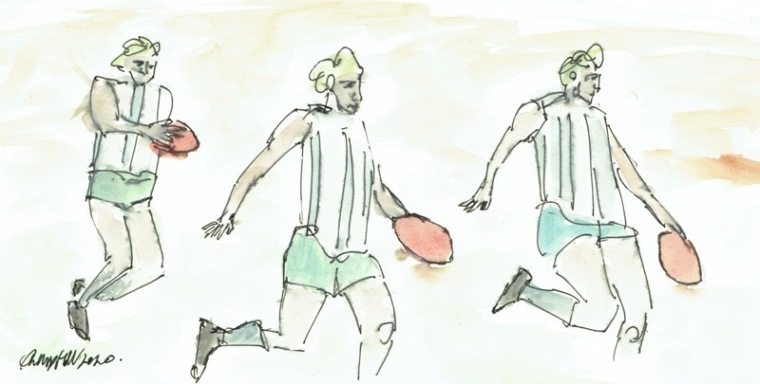
Like a lot of people who have watched Australian Rules football over the last thirty years I wonder why scoring is so hard. There is no goal keeper. Unlike basketball the goal is wider and vastly taller than the ball. In contrast the scoring averages per season show a decrease beginning in the 1990s.
Searching for Another Cause
Professionalism and specialisation in all areas of player development and coaching was supposed to make the game better. Players are managed to the second to get the best out of their game time. Which has many pointing at an over use of the interchange as the main culprit.
However, Correlation is not Causation. Despite events occurring at the same time as the change, such an event is rarely the culprit. Many factors have created the way the game is currently played. Do we know all of the multiple causes for the lack of scoring in the AFL? I believe I have found one that is overlooked.
Barry Cable Kicks Good
In my search I came across the 1974 VFL Grand Final between Richmond and North Melbourne. The highlight due to his skills was North Melbourne player Barry Cable. This was Richmond in the 1970’s with some of the best players in Tigers history. No one on that field was as gifted as Cable when it came to kicking.
Barry Cable played in the WAFL and then VFL amassing praise, accolades and grand finals as both player and coach. Cable has a huge bag of skills that are today ignored as relics of the game. Even now there are tricks that he asserts could help players who are skilled enough.
If you can, watch the 1974 Grand Final and count the different kicks Cable puts to use. Drop kicks, Stab passes, Flat Punts, Drop Punts. My Dad said Cable’s stab passes would hit with enough force to knock you on your back. You can see Cable use all the different ways to kick the ball.
Not The Same Ball
The ball though, is different. Yes the ball used is not the same ball as used in the AFL today. The current official ball is smaller and thinner. The difference is seen in the old footage. Not just in the way the ball looks bigger in the players hands. The ball bounces differently.
Erratic nowhere near the standard bounce pattern of today’s smaller football. If you doubt please watch the footage of the 1974 Grand Final. My Dad and I noticed it. I thought the ground was not in the same condition. It was the VFL Grand Final. The under 18s and Reserves had played earlier on the same ground. The MCG was more mud than grass.
Kicking and Hand-passing of this ball was not the same. The unpredictability of the bounce was hard to ignore. When Aussie Rules began they used Rugby balls, which are bigger. As the rules coalesced over time manufacturers developed the ball as well. Change is a constant in Aussie Rules.
The Shrinking Ball
Over time the official ball used has gotten smaller. In 1892 the official ball was 26 inches in circumference and 31 inches in length. By 2013 the ball has a circumference of 21.85 inches (555mm) and a length of 28.74 inches (730mm).
2013’s modifications were not just shifting to metric. They were the results of an investigation commissioned by the AFL to make a better ball. The ISEAL (Institute of Sport, Exercise and Active Living) from Victoria University were lead by Hans Westerbeek.
Westerbeek looks to the innovations of European an American football codes noting that these innovations are not favoured in Australia. Westerbeek offers the other codes looked for certain performance characteristics for their footballs. These were the guide for manufacturers to use and create new and improved footballs. Modern footballs for the modern game.
ISEAL’s investigation included players and manufacturers. Findings resulted with a smaller, though still leather ball. The bounce is of course more predictable and the handling is easier. Players preferred yellow over traditional red.
The results since are interesting. The AFL goal averages in 2012 were 13.3. In 2013 13.4. In 2014 12.6 which drops further in 2019 to 11.9. Correlation is not causation. However I am sure that the changes in ball size have contributed to the decline in scoring. One of many changes.
Multiple Causes Over Time
In the 1970’s Aussie Rules saw a change in how the ball was kicked. Multiple ways of kicking were replaced by the drop punt. By the 1980s one kick became dominant. In the 1990s defensive tactics got better, more organised, the game changed again.
Professionalism and an increase in coaching and support staff accelerated. Further acerbated by calculated analysis of the players peak performance on field and enhanced the use of the interchange. Players are manged and trained in an environment that is totally unlike that of Barry Cable’s era.
In the midst of all of this the ball was made more manageable, easier to handle, easier to handball and run with? The bounce is so predictable that goals are kicked along the ground. A predictability that can be depended upon by defensive players as much as goal kickers. A dynamic part of the game the balls unpredictability was removed.
Along with the balls unpredictability in bouncing is the footballs size. A bigger ball is easier to kick, a larger target for the foot to gain purchase on. You watch the older ball through the air and it travels differently. Obviously this would make it difficult for defenders and forwards.
Smaller Ball, Smaller Target, Less Accuracy?
By making the ball easier to handle we have made it more predictable, however has this been part of the issue with scoring. Elite runners who use their legs to run are not goal kickers. Even if they are goal kickers are they being given an unfair disadvantage due to the size of the ball? It all comes down to the desired performance characteristics. Does the AFL want close low scoring?
Where do I want to take this? Well, I want to see how modern footballers would play with the larger ball of the 1970’s. Could it change the way the game is played? I do not know but it is one change that can be tested out. Sherrin? AFL? Coodabeens? ABC Grandstand? Anybody want to rise to the challenge? #biggerfootball.
1974 Grand Final - https://www.youtube.com/watch?v=jcnNAgyT9l8
Barry Cable still got it - https://youtu.be/ZWLnLfYiH14
Kicking History - https://youtu.be/cHN7vzarc58
AFL Tables Year Averages - https://afltables.com/afl/stats/yearly.html

Phillip Hall has been too long in Melbourne to see AFL in the same light as those back in Fremantle. East Fremantle born and bred, he would love to see the Dockers back in the eight. But would settle for just beating West Coast twice a year.